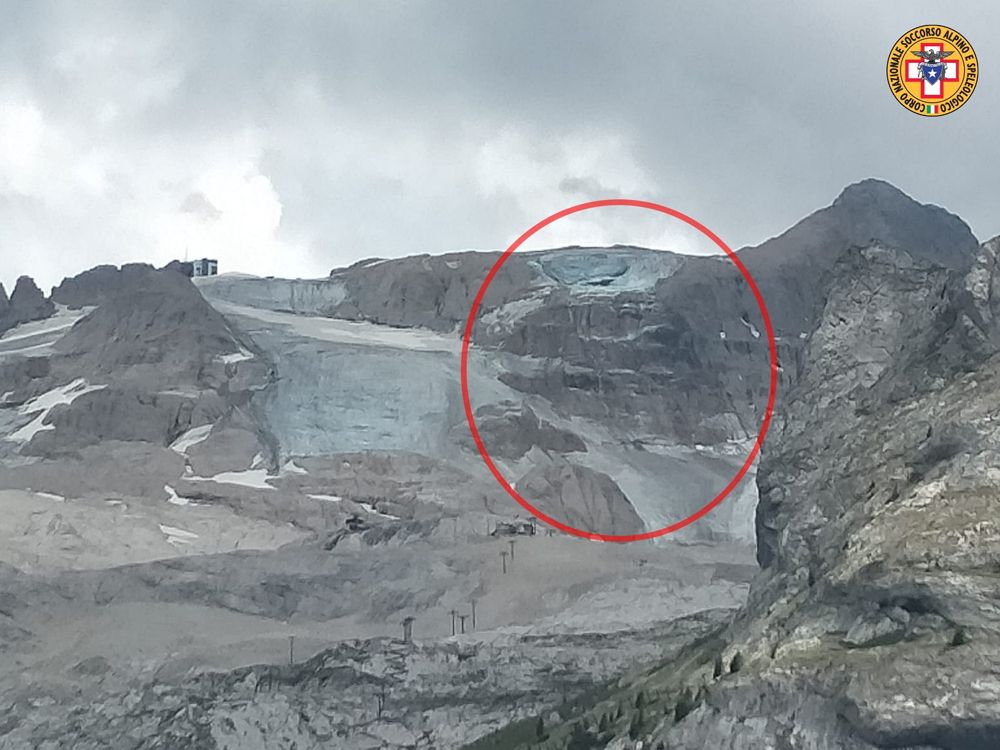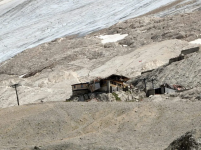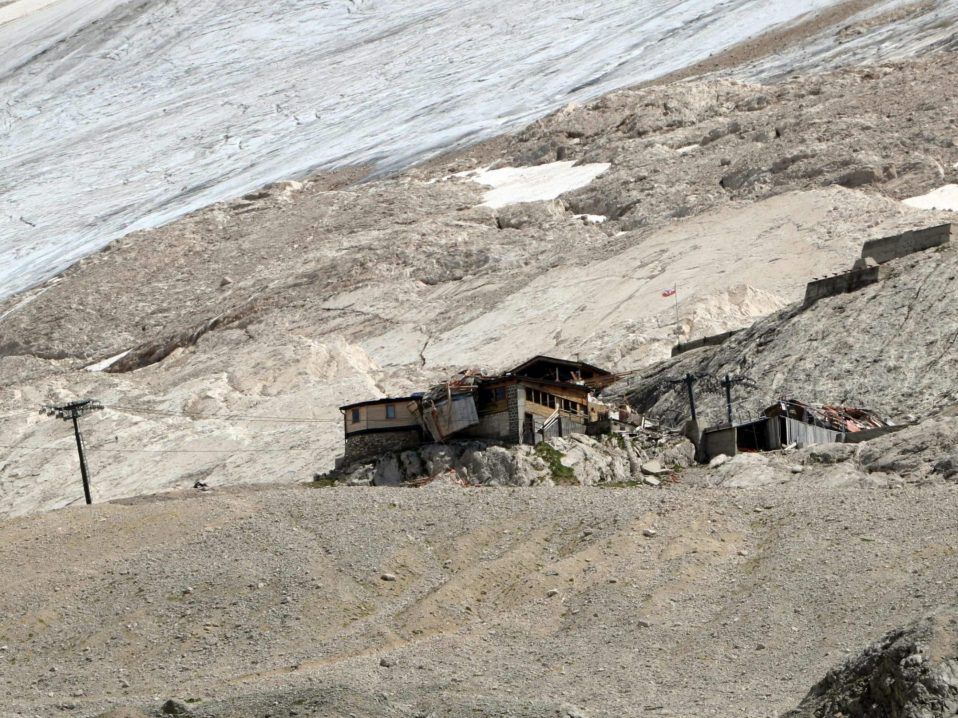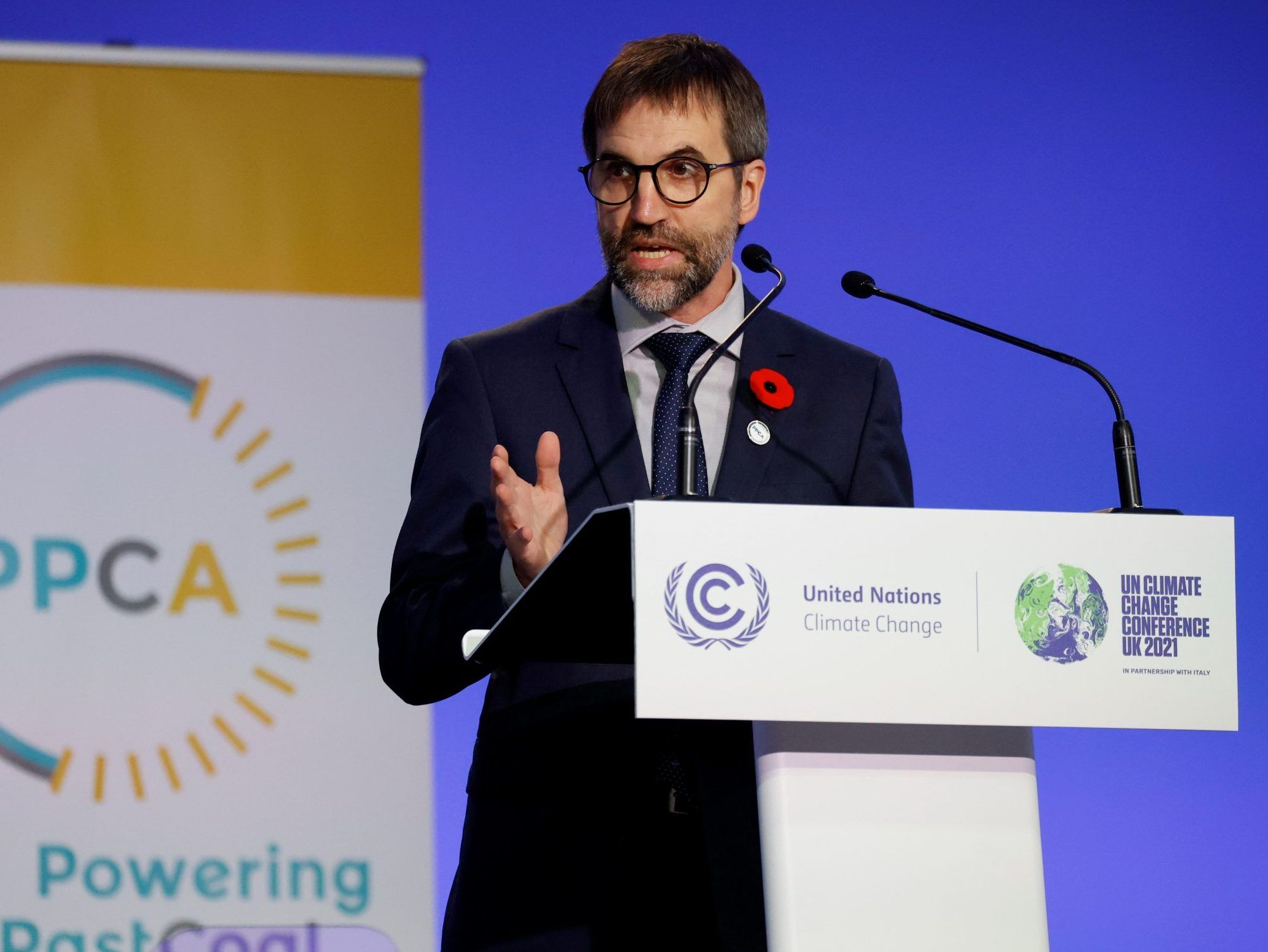It's Climate Change I tell'ya!! IT'S CLIMATE CHANGE!!
- Thread starter B00Mer
- Start date
You are using an out of date browser. It may not display this or other websites correctly.
You should upgrade or use an alternative browser.
You should upgrade or use an alternative browser.
Still have a crop if planted before July 15 especially with a Polish varietyDo you have time to grow Oats in SK? It's already a pretty short growing season there and you now have lost 2 months.
55-60 days for oats. There is plenty of time to fully mature.Still have a crop if planted before July 15 especially with a Polish variety
Looks like Vancouver after a pride parade .
Italian glacier collapses, killing at least six hikers
Author of the article:Associated Press
Associated Press
Publishing date:Jul 03, 2022 • 10 hours ago • 3 minute read • Join the conversation
ROME — A large chunk of an Alpine glacier broke loose Sunday and roared down a mountain in Italy, sending ice, snow and rock slamming into hikers on a popular trail on the peak and killing at least six and injuring nine, authorities said, warning that the toll might climb.
A local Civil Protection official, Gianpaolo Bottacin, was quoted by the Italian news agency ANSA as providing the toll, but stressing that the situation was “evolving” and that there could be perhaps 15 people missing.
In late evening, the National Alpine and Cave Rescue Corps tweeted a phone number to call for family or friends in case of “failure to return from possible excursions” to the glacier.
Rescuers were checking license plates in the parking lot as part of checks to determine how many people might be unaccounted for, a process that could take hours, Corps spokesman Walter Milan told The Associated Press by telephone.
The glacier, in the Marmolada range, is the largest in the Dolomite mountains in northeastern Italy and people ski there in the winter. But the glacier has been rapidly melting away in recent years.
Experts at Italy’s state-run CNR research center, which has a polar sciences institute, says the glacier won’t exist anymore in the next 25-30 years and much of its volume is already gone.
The Mediterranean basin, shared by southern Europe, the Middle East and northern Africa, has been identified by U.N. experts as a “climate change hot spot,” likely to suffer heat waves and water shortages, among other consequences.
“We saw dead (people) and enormous chunks of ice, rock,” exhausted-looking rescuer Luigi Felicetti told Italian state TV.
Nationalities or ages of the dead weren’t immediately available, Milan said.
Of the hospitalized survivors, two were in grave condition, authorities said.
The fast-moving avalanche “came down with a roar the could be heard at great distance,” local online media site ildolomiti.it said.
Temporarily, the search by helicopter and dogs for any more victims or missing was halted for the night while rescuers evaluated the risk that more of the glacier could break off, Walter Cainelli, after conducting a rescue mission with a search dog, told state television.
Rescuers said blocks of ice were continuing to tumble down. In early evening, a light rain began to fall.
The SUEM dispatch service, which is based in the nearby Veneto region, said 18 people who were above the area where the ice struck would be evacuated by the Alpine rescue corps.
Some of those making the trek in the area where the avalanche barreled through were tied together by rope, according to local emergency services.
But Milan said some of the hikers might be able to get down by themselves, including by using the peak’s cable car.
SUEM said the avalanche consisted of a “pouring down of snow, ice and rock.” The detached section is know as a serac, or pinnacle of ice.
Dubbed the “queen of the Dolomites,” Marmolada rises about 3,300 meters (about 11,000 feet) and is the highest of the 18 peaks in that eastern range of the Italian Alps, offering spectacular views of other Alpine peaks.
The Alpine rescue service said in a tweet that the segment broke off near Punta Rocca (Rock Point), “along the itinerary normally used to reach the peak.”
It wasn’t immediately clear what caused the section of ice to break away and rush down the peak’s slope. But the intense heat wave gripping Italy since late June loomed as a possible factor.
“The temperatures of these days clearly had influence” on the glacier’s partial collapse, Maurizio Fugatti, the president of Trento Province, which borders Marmolada, told Sky TG24 news.
But Milan stressed that high heat, which soared unusually above 10 C (50 F) on Marmolada’s peak in recent days, was only one possible factor in Sunday’s tragedy.
“There are so many factors that could be involved,” Milan said. Avalanches in general aren’t predictable, he said, and heat’s influence on a glacier “is even more impossible to predict.”
In separate comments to Italian state television, Milan called the recent temperatures “extreme heat” for the peak. “Clearly it’s something abnormal.”
The injured were flown to several hospitals in the regions of Trentino-Alto Adige and Veneto, according to rescue services.
As in other cases of disasters amid nature in Italy, prosecutors opened an investigation to see if there was any indication of possible wrongdoing linked to the avalanche.


 torontosun.com
torontosun.com
Author of the article:Associated Press
Associated Press
Publishing date:Jul 03, 2022 • 10 hours ago • 3 minute read • Join the conversation
ROME — A large chunk of an Alpine glacier broke loose Sunday and roared down a mountain in Italy, sending ice, snow and rock slamming into hikers on a popular trail on the peak and killing at least six and injuring nine, authorities said, warning that the toll might climb.
A local Civil Protection official, Gianpaolo Bottacin, was quoted by the Italian news agency ANSA as providing the toll, but stressing that the situation was “evolving” and that there could be perhaps 15 people missing.
In late evening, the National Alpine and Cave Rescue Corps tweeted a phone number to call for family or friends in case of “failure to return from possible excursions” to the glacier.
Rescuers were checking license plates in the parking lot as part of checks to determine how many people might be unaccounted for, a process that could take hours, Corps spokesman Walter Milan told The Associated Press by telephone.
The glacier, in the Marmolada range, is the largest in the Dolomite mountains in northeastern Italy and people ski there in the winter. But the glacier has been rapidly melting away in recent years.
Experts at Italy’s state-run CNR research center, which has a polar sciences institute, says the glacier won’t exist anymore in the next 25-30 years and much of its volume is already gone.
The Mediterranean basin, shared by southern Europe, the Middle East and northern Africa, has been identified by U.N. experts as a “climate change hot spot,” likely to suffer heat waves and water shortages, among other consequences.
“We saw dead (people) and enormous chunks of ice, rock,” exhausted-looking rescuer Luigi Felicetti told Italian state TV.
Nationalities or ages of the dead weren’t immediately available, Milan said.
Of the hospitalized survivors, two were in grave condition, authorities said.
The fast-moving avalanche “came down with a roar the could be heard at great distance,” local online media site ildolomiti.it said.
Temporarily, the search by helicopter and dogs for any more victims or missing was halted for the night while rescuers evaluated the risk that more of the glacier could break off, Walter Cainelli, after conducting a rescue mission with a search dog, told state television.
Rescuers said blocks of ice were continuing to tumble down. In early evening, a light rain began to fall.
The SUEM dispatch service, which is based in the nearby Veneto region, said 18 people who were above the area where the ice struck would be evacuated by the Alpine rescue corps.
Some of those making the trek in the area where the avalanche barreled through were tied together by rope, according to local emergency services.
But Milan said some of the hikers might be able to get down by themselves, including by using the peak’s cable car.
SUEM said the avalanche consisted of a “pouring down of snow, ice and rock.” The detached section is know as a serac, or pinnacle of ice.
Dubbed the “queen of the Dolomites,” Marmolada rises about 3,300 meters (about 11,000 feet) and is the highest of the 18 peaks in that eastern range of the Italian Alps, offering spectacular views of other Alpine peaks.
The Alpine rescue service said in a tweet that the segment broke off near Punta Rocca (Rock Point), “along the itinerary normally used to reach the peak.”
It wasn’t immediately clear what caused the section of ice to break away and rush down the peak’s slope. But the intense heat wave gripping Italy since late June loomed as a possible factor.
“The temperatures of these days clearly had influence” on the glacier’s partial collapse, Maurizio Fugatti, the president of Trento Province, which borders Marmolada, told Sky TG24 news.
But Milan stressed that high heat, which soared unusually above 10 C (50 F) on Marmolada’s peak in recent days, was only one possible factor in Sunday’s tragedy.
“There are so many factors that could be involved,” Milan said. Avalanches in general aren’t predictable, he said, and heat’s influence on a glacier “is even more impossible to predict.”
In separate comments to Italian state television, Milan called the recent temperatures “extreme heat” for the peak. “Clearly it’s something abnormal.”
The injured were flown to several hospitals in the regions of Trentino-Alto Adige and Veneto, according to rescue services.
As in other cases of disasters amid nature in Italy, prosecutors opened an investigation to see if there was any indication of possible wrongdoing linked to the avalanche.


Avalanche leaves 7 known dead, 13 missing in Italy
Storms hampered the search for more than a dozen hikers who remained unaccounted for after a chunk of an Alpine glacier in Italy broke off.
Body parts, gear found on Italian glacier after avalanche
A huge chunk of the glacier cleaved off Sunday, sparking an avalanche that sent torrents of ice, rock and debris plowing down
Author of the article:Associated Press
Associated Press
Paolo Santalucia, Andrea Rosa And Nicole Winfield
Publishing date:Jul 05, 2022 • 11 hours ago • 4 minute read • Join the conversation
A picture taken Tuesday, July 5, 2022 near Canazei shows the destroyed arrival station of the chairlift two days after a block of glacial ice collapsed, killing seven people.
A picture taken Tuesday, July 5, 2022 near Canazei shows the destroyed arrival station of the chairlift two days after a block of glacial ice collapsed, killing seven people. PHOTO BY PIERRE TEYSSOT / AFP /Getty Images
Article content
CANAZEI, Italy — Rescuers found body parts and equipment as they searched Tuesday for hikers missing following a powerful avalanche that killed at least seven people and was blamed in large part on rising temperatures that are melting glaciers.
Officials initially feared 13 hikers were still missing after a huge chunk of the Marmolada glacier cleaved off Sunday in northern Italy. But the province of Trento on Tuesday reduced the number of people unaccounted-for to five, all of them Italian, after eight others checked in with authorities.
One of them is Erica Campagnaro, and on Tuesday her sister Debora Campagnaro, lashed out at the lack of warning about the accumulation of water at the base of the glacier that experts say was evidence of an unusual melt from a heat wave that has been scorching Italy for weeks.
Campagnaro said her sister and brother-in-law, an experienced Alpine guide who is also among the missing, never would have left their two sons at home to go hiking if there had been an alert system as there is in ski season warning about the possibility of snow avalanches.
“Is there an authority that had to prevent people (from going up the mountain) given the weather of that day and the weather of the previous days? Where is this authority?” she asked at the site of the rescue camp.
Rain had hampered the search Monday, but sunny weather on Tuesday allowed helicopters to bring more rescue teams and their drones up to the site on the glacier, east of Bolzano in the Dolomite mountains, even as hopes dimmed of finding anyone alive.
“We have to be clear, finding someone alive with this type of event is a very remote possibility, very remote, because the mechanical action of this type of avalanche has a very big impact on people,” said Alex Barattin of the Alpine Rescue Service.
After the 200-meter (yard) wide chunk of glacier detached, a torrent of ice, rock and debris plowed down the mountainside onto unsuspecting hikers below. At least seven people were killed, two of them Czech, officials said.
Nicola Casagli, a geologist and avalanche expert at Florence University, said the impact of the glacier collapse on the hikers was greater than a mere snow avalanche and would have taken them completely by surprise.
“These types of events, which are ice and debris avalanches, are impulsive, rapid, unpredictable phenomena, reaching very high speeds and involving large masses,” he said. “And there is no chance of getting to safety or perceiving the problem in advance, because by the time you perceive it, you’ve already been hit.”
Associated Press photos, taken during a helicopter survey of the site, showed a gaping hole in the glacier as if the blue-gray ice had been carved out by a giant ice cream scooper.
The terrain was still so unstable that rescue crews stayed off to the side and were using drones to try to find any remains or signs of life while helicopters searched overhead, some using equipment to detect cellular pings.
Maurizio Dellantonio, national president of the Alpine Rescue Service, said teams had found body parts, hiking equipment and clothing on the surface of the debris, evidence of the avalanche’s powerful impact on the hikers.
“We have recovered so many fragments over the last two days. They are very painful for those who pick them up. and then for those who have to analyze them,” he said. “Personally I can only think that what we found on the surface will be the same that we will find underneath, when the ice will melt or by digging, if there is a chance.”
By late Tuesday, he said technical teams had determined it was safe enough for ground rescue workers to start searching the lowest part of the debris, about 700 meters below the detachment site, where drones weren’t working well anyway.
Officials closed all access routes and chair lifts to the glacier for hikers, fearing continued instability and the potential that more chunks of ice might detach.
Premier Mario Draghi, who visited the rescue base in Canazei on Monday, acknowledged avalanches are unpredictable but that the tragedy “certainly depends on the deterioration of the climate situation.”
Italy is in the midst of an early summer heatwave, coupled with the worst drought in northern Italy in 70 years that prompted the government to declare a state of emergency in five northern regions. Experts say there was unusually little snowfall during the winter, exposing the glaciers of the Italian Alps more to the summer heat and melt.
“We are thus in the worst conditions for a detachment of this kind, when there’s so much heat and so much water running at the base,” said Renato Colucci from the Institute of Polar Sciences of the state-run Council for National Research, or CNR.
The CNR has estimated that the Marmolada glacier could disappear entirely in the next 25-30 years if current climatic trends continue, given that it lost 30% of its volume and 22% of its area from 2004-2015.
Maurizio Fugatti, president of the autonomous province of Trento, insisted though that Sunday’s detachment was an “exceptional event, one of a kind,” when asked about why hikers such as Campagnaro and her husband had been allowed on the glacier.
“There were many alpine guides on that side (of the glacier), people who know very well what the situation is,” he said. “On the other hand we can understand the feeling of the relatives and friends of those people affected.”
Casagli said what happened on the Marmolada was unusual, but said such destructive avalanches will become more frequent as global temperatures continue to rise.
“The fact that it happened in a scorching summer with abnormal temperatures must be a wake-up call to understand that these phenomena, while rare, are possible,” he told reporters. “If we don’t take decisive measures to counter the effects of climate change, they will become more and more frequent.”
— Winfield reported from Rome.


 torontosun.com
torontosun.com
A huge chunk of the glacier cleaved off Sunday, sparking an avalanche that sent torrents of ice, rock and debris plowing down
Author of the article:Associated Press
Associated Press
Paolo Santalucia, Andrea Rosa And Nicole Winfield
Publishing date:Jul 05, 2022 • 11 hours ago • 4 minute read • Join the conversation
A picture taken Tuesday, July 5, 2022 near Canazei shows the destroyed arrival station of the chairlift two days after a block of glacial ice collapsed, killing seven people.
A picture taken Tuesday, July 5, 2022 near Canazei shows the destroyed arrival station of the chairlift two days after a block of glacial ice collapsed, killing seven people. PHOTO BY PIERRE TEYSSOT / AFP /Getty Images
Article content
CANAZEI, Italy — Rescuers found body parts and equipment as they searched Tuesday for hikers missing following a powerful avalanche that killed at least seven people and was blamed in large part on rising temperatures that are melting glaciers.
Officials initially feared 13 hikers were still missing after a huge chunk of the Marmolada glacier cleaved off Sunday in northern Italy. But the province of Trento on Tuesday reduced the number of people unaccounted-for to five, all of them Italian, after eight others checked in with authorities.
One of them is Erica Campagnaro, and on Tuesday her sister Debora Campagnaro, lashed out at the lack of warning about the accumulation of water at the base of the glacier that experts say was evidence of an unusual melt from a heat wave that has been scorching Italy for weeks.
Campagnaro said her sister and brother-in-law, an experienced Alpine guide who is also among the missing, never would have left their two sons at home to go hiking if there had been an alert system as there is in ski season warning about the possibility of snow avalanches.
“Is there an authority that had to prevent people (from going up the mountain) given the weather of that day and the weather of the previous days? Where is this authority?” she asked at the site of the rescue camp.
Rain had hampered the search Monday, but sunny weather on Tuesday allowed helicopters to bring more rescue teams and their drones up to the site on the glacier, east of Bolzano in the Dolomite mountains, even as hopes dimmed of finding anyone alive.
“We have to be clear, finding someone alive with this type of event is a very remote possibility, very remote, because the mechanical action of this type of avalanche has a very big impact on people,” said Alex Barattin of the Alpine Rescue Service.
After the 200-meter (yard) wide chunk of glacier detached, a torrent of ice, rock and debris plowed down the mountainside onto unsuspecting hikers below. At least seven people were killed, two of them Czech, officials said.
Nicola Casagli, a geologist and avalanche expert at Florence University, said the impact of the glacier collapse on the hikers was greater than a mere snow avalanche and would have taken them completely by surprise.
“These types of events, which are ice and debris avalanches, are impulsive, rapid, unpredictable phenomena, reaching very high speeds and involving large masses,” he said. “And there is no chance of getting to safety or perceiving the problem in advance, because by the time you perceive it, you’ve already been hit.”
Associated Press photos, taken during a helicopter survey of the site, showed a gaping hole in the glacier as if the blue-gray ice had been carved out by a giant ice cream scooper.
The terrain was still so unstable that rescue crews stayed off to the side and were using drones to try to find any remains or signs of life while helicopters searched overhead, some using equipment to detect cellular pings.
Maurizio Dellantonio, national president of the Alpine Rescue Service, said teams had found body parts, hiking equipment and clothing on the surface of the debris, evidence of the avalanche’s powerful impact on the hikers.
“We have recovered so many fragments over the last two days. They are very painful for those who pick them up. and then for those who have to analyze them,” he said. “Personally I can only think that what we found on the surface will be the same that we will find underneath, when the ice will melt or by digging, if there is a chance.”
By late Tuesday, he said technical teams had determined it was safe enough for ground rescue workers to start searching the lowest part of the debris, about 700 meters below the detachment site, where drones weren’t working well anyway.
Officials closed all access routes and chair lifts to the glacier for hikers, fearing continued instability and the potential that more chunks of ice might detach.
Premier Mario Draghi, who visited the rescue base in Canazei on Monday, acknowledged avalanches are unpredictable but that the tragedy “certainly depends on the deterioration of the climate situation.”
Italy is in the midst of an early summer heatwave, coupled with the worst drought in northern Italy in 70 years that prompted the government to declare a state of emergency in five northern regions. Experts say there was unusually little snowfall during the winter, exposing the glaciers of the Italian Alps more to the summer heat and melt.
“We are thus in the worst conditions for a detachment of this kind, when there’s so much heat and so much water running at the base,” said Renato Colucci from the Institute of Polar Sciences of the state-run Council for National Research, or CNR.
The CNR has estimated that the Marmolada glacier could disappear entirely in the next 25-30 years if current climatic trends continue, given that it lost 30% of its volume and 22% of its area from 2004-2015.
Maurizio Fugatti, president of the autonomous province of Trento, insisted though that Sunday’s detachment was an “exceptional event, one of a kind,” when asked about why hikers such as Campagnaro and her husband had been allowed on the glacier.
“There were many alpine guides on that side (of the glacier), people who know very well what the situation is,” he said. “On the other hand we can understand the feeling of the relatives and friends of those people affected.”
Casagli said what happened on the Marmolada was unusual, but said such destructive avalanches will become more frequent as global temperatures continue to rise.
“The fact that it happened in a scorching summer with abnormal temperatures must be a wake-up call to understand that these phenomena, while rare, are possible,” he told reporters. “If we don’t take decisive measures to counter the effects of climate change, they will become more and more frequent.”
— Winfield reported from Rome.


Body parts, gear found on Italian glacier after avalanche
Rescuers found body parts and equipment as they searched Tuesday for hikers missing following a powerful avalanche in Italy.
Coldest year in the Northern Hemisphere since 1958....
I believe that! I'm still waiting for spring & summer to come LOLColdest year in the Northern Hemisphere since 1958....
Wow….if Federal Liberal Environment Minister Steven Guilbeault plans on stopping in Regina…he’d better bring his bicycle (and pack a lunch or two) also to get from the closest train station to the Legislative Building in Regina.
View attachment 10858
Guilbeault's cross-country climate train tour derailed by lack of service — National Post
The plan faced challenges from the very start, mainly because five of Canada’s provincial capitals are not served by Via Rail's passenger service
“I look forward to travelling across the country early in the new year, by train, to meet and discuss (climate change) with Canadians in all parts of the country,” the minister told reporters.
So ‘bout 110 miles, each way, from the closest train station. Buddy might have to jump on STC or a Greyhound Bus if it’s too far to spread out & lessen his Carbon Footprint….if such a thing as STC or a Greyhound Bus existed along that route.
Maybe he should be financially punitively punished if he doesn’t use public transport between those two points?
Or someone else will have to make that round trip, twice, to get him from and back to that closest train station, plus some incidental mileage, so call that 500 miles (800 kms?) assuming he and his Entourage all fit into just one vehicle…& this is a prairie reality that we’re suppose to lesson our carbon footprint from with increasing carbon taxes every April Fools Day? http://forums.canadiancontent.net/threads/april-fools-heres-your-carbon-tax-f-ckers.163090/
But the plan faced challenges from the very start, mainly because five of Canada’s provincial capitals are not served by Via Rail’s passenger rail service and because, in the places it does operate, Via had repeatedly and significantly reduced departures due to the pandemic.I think both STC and Greyhound are figments of our imagination now ... a memory from times gone by.
Guilbeault’s office confirmed Tuesday that the minister’s ambitious early-2022 train tour plan didn’t happen in part because of the sixth COVID-19 wave, but also because Via Rail simply was not offering the required service levels to make it possible.BONOKOSKI: Environment Minister Steven Guilbeault finally forced to choose his poison
Author of the article:Mark Bonokoski
Publishing date:Nov 18, 2021 • 16 hours ago • 3 minute read • 25 Comments
Minister of Environment and Climate Change Steven Guilbeault speaks during the UN Climate Change Conference (COP26), in Glasgow, Scotland, Nov. 4, 2021.
Minister of Environment and Climate Change Steven Guilbeault speaks during the UN Climate Change Conference (COP26), in Glasgow, Scotland, Nov. 4, 2021. PHOTO BY PHIL NOBLE /REUTERS
Article content
So Environment Minister Steven Guilbeault is going to take the train this winter to preach his gospel on climate change.
Advertisement
STORY CONTINUES BELOW
Article content
He’s chosen his primary poison.
Before this snapshot, he’s ridden his bike three decades though the winters of Montreal — or so he’s posted on Facebook.
But these are different times.
As Minister of the Environment, he’s entitled to a government-issue car and driver, as well as jet planes.
“I’ve been asked many times over the past few weeks whether I realize just how high expectations are for me given my activist history and whether I’m prepared to make compromises,” said Guilbeault, a former Greenpeace organizer.
“What I’ve said, and I mean it, is I recognize expectations are high as they should be,” he said. “That’s because the stakes are very high, and the mandate that Canadians gave us is an extremely ambitious one.”
Advertisement
STORY CONTINUES BELOW
Article content
“I am the father of four kids and as I’m sure the parents among you can relate, I never win every single battle at home,” Guilbeault told reporters. “If that’s true of my family, of course it’s going to be true of a society like Canada or on the global stage. But that’s not going to stop me, or Canada, to keep fighting this battle.”
Perhaps he should consider taking those four kids along because a transcontinental train service takes six days to carry passengers from Halifax to Vancouver and there’s a lot of down time, and not just because the railway acknowledges it is often late by as much as a day.
There can be hour upon hours just between stops
And that’s a lot of down time with four kids.
In a Summary Of The 2018-2022 Corporate Plan, VIA management said performance was “terrible” for its transcontinental Canadian service where delays of eight hours or more were routine.
Advertisement
STORY CONTINUES BELOW
Article content
On-time performance for all VIA Rail trains prior to the pandemic was 68% even after the railway redefined “on time” to mean as much as 15 minutes late on short hauls.
Guilbeault acknowledged VIA has an on-time problem, just as Canada has never met the successive emissions targets “we have been promising since the 1990s.”
Targets are challenging, he said: “I’ve been at this climate fight for a long time. We have our work cut out for us.”
Catherine McKenna in her last act as minister of the environment pulled out her government credit card and logged 22,600 kilometres by air in ten days last July on a climate change tour of Canada.
On various legs of her tour, McKenna was accompanied by as many as nine staff, including two press aides.
Advertisement
STORY CONTINUES BELOW
Article content
“We need to reduce air pollution,” McKenna said at a July 27 stop in Edmonton. “Consider that the transportation sector represents a quarter of Canada’s greenhouse gas emissions.”
Whether Guilbeault takes a train, boat or plane — as he flew to-and-from the COP26 summit in Glasgow where no agreement on time was again met — he will be doing a lot of polluting.
Flights produce greenhouse gases — mainly carbon dioxide — from burning jet fuel, and obviously contributes to global warming when released into the atmosphere.
An economy-class return flight from London to New York, says the BBC, emits an estimated 0.67 tonnes of CO2 per passenger, according to the calculator from the UN’s civil aviation body.
That’s equivalent to 11% of the average annual emissions for someone living, say, in Canada, over a year.
Two passengers travelling by car from, say, London to Madrid, will put out less pollution than a jam-packed jetliner on the same run.
Just a driver, however, and the jetliner wins.
Guilbeault will constantly be choosing his poison.
markbonokoski@gmail.com

BONOKOSKI: Environment Minister Steven Guilbeault finally forced to choose his poison
So Environment Minister Steven Guilbeault is going to take the train this winter to preach his gospel on climate change.torontosun.com
View attachment 10861
Guilbeault’s director of communication Oliver Anderson said that Via Rail’s reduced service prevented the office from being “able to bring together something that would be billed as a cross-country tour just because it was not logistically feasible.”Id like to see him try it in June without using any deet.
In an email Tuesday, his office added, “Due to VIA Rail’s continued reduced capacity on their rail lines due to COVID as well as train car maintenance, logistically, it was not feasible to conduct a meaningful tour this year in all parts of the country.”
Via Rail’s limited service from Toronto to Vancouver dropped to once a week during the pandemic. It was then expected to jump to three times as pandemic public health measures dropped across the country, but as of now remains at two weekly departures.Liberals and reality parted ways in 1970.
According to Guilbeault’s office, that meant that as soon as the minister got off the train for a stop, he’d have to wait up to four days for the next train to pick him up.
According to Guilbeault’s office, that meant that as soon as the minister got off the train for a stop, he’d have to wait up to four days for the next train to pick him up.
That's a dangerous amount of time to spend in hostile territory. The Lieberal runs the risk of hearing from the people and returning to reality from the Lieberal cloud. Must be avoided.
That's gonna piss some people off isn't it?
Of course. He's a hard-core conservative Republican with BAs in History and English from the University of Kansas!That's gonna piss some people off isn't it?
You're too funny Tech! Didn't realize that NASA went to school LOLOf course. He's a hard-core conservative Republican with BAs in History and English from the University of Kansas!
Some of us are old enough to remember this stuff. Lol. Share with the youngsters. https://cei.org/blog/wrong-again-50-years-of-failed-eco-pocalyptic-predictions/




